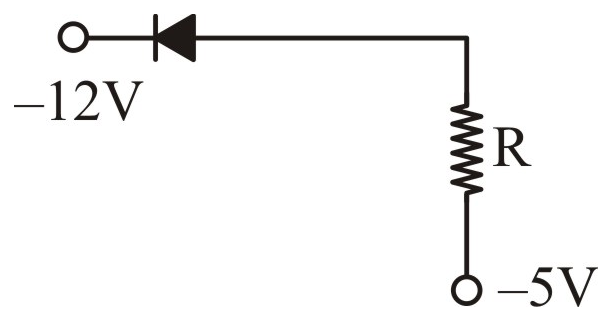Select Chapter Topics:
The following table is for which logic gate?
Input
Output
A
B
C
0
0
1
0
1
1
1
0
1
1
1
0
1. AND
2. OR
3. NAND
4. NOT
1. AND
2. OR
3. NAND
4. NOT
Subtopic: Logic gates |
87%
From NCERT
AIPMT - 1998
To view explanation, please take trial in the course.
NEET 2025 - Target Batch
Hints
To view explanation, please take trial in the course.
NEET 2025 - Target Batch
Zener diode is used for:
1. rectification.
2. stabilisation.
3. amplification.
4. producing oscillations in an oscillator.
Subtopic: Applications of PN junction |
71%
From NCERT
AIPMT - 2005
To view explanation, please take trial in the course.
NEET 2025 - Target Batch
Hints
To view explanation, please take trial in the course.
NEET 2025 - Target Batch
Given Truth table is correct for:
1. NAND
2. AND
3. NOR
4. OR
| \(A\) | \(B\) | \(Y\) |
| \(1\) | \(1\) | \(1\) |
| \(1\) | \(0\) | \(0\) |
| \(0\) | \(1\) | \(0\) |
| \(0\) | \(0\) | \(0\) |
2. AND
3. NOR
4. OR
Subtopic: Logic gates |
86%
From NCERT
AIPMT - 2000
To view explanation, please take trial in the course.
NEET 2025 - Target Batch
Hints
To view explanation, please take trial in the course.
NEET 2025 - Target Batch
Identify the incorrect statement from the following:
| 1. | The resistivity of a semiconductor increases with an increase in temperature. |
| 2. | Substances with an energy gap of the order of \(10\) eV are insulators. |
| 3. | In conductors, the valence and conduction bands may overlap. |
| 4. | The conductivity of a semiconductor increases with an increase in temperature. |
Subtopic: Energy Band theory |
78%
From NCERT
AIPMT - 2005
To view explanation, please take trial in the course.
NEET 2025 - Target Batch
Hints
To view explanation, please take trial in the course.
NEET 2025 - Target Batch
Application of a forward bias to a \(\mathrm{p\text-n}\) junction:
| 1. | widens the depletion zone. |
| 2. | increases the number of donors on the n side. |
| 3. | increases the potential difference across the depletion zone. |
| 4. | increases the electric field in the depletion zone. |
Subtopic: PN junction |
55%
From NCERT
AIPMT - 2005
To view explanation, please take trial in the course.
NEET 2025 - Target Batch
Hints
To view explanation, please take trial in the course.
NEET 2025 - Target Batch
If a common emitter circuit is used as an amplifier, its current gain is \(50.\) If input resistance is \(1\) kΩ and input voltage is \(5\) V, then output current will be:
1. \(250\) mA
2. \(30\) mA
3. \(50\) mA
4. \(100\) mA
Subtopic: Applications of Transistor (OLD NCERT) |
77%
From NCERT
AIPMT - 1998
To view explanation, please take trial in the course.
NEET 2025 - Target Batch
Hints
To view explanation, please take trial in the course.
NEET 2025 - Target Batch
Of the diodes shown in the following diagrams, which one of the diodes is reverse biased?
| 1. |  |
2. |  |
| 3. |  |
4. |  |
Subtopic: PN junction |
83%
From NCERT
AIPMT - 2004
To view explanation, please take trial in the course.
NEET 2025 - Target Batch
Hints
To view explanation, please take trial in the course.
NEET 2025 - Target Batch
The truth table for the following network is:
| 1. |
|
|||||||||||||||
| 2. |
|
|||||||||||||||
| 3. |
|
|||||||||||||||
| 4. | None of the above |
Subtopic: Logic gates |
76%
From NCERT
AIPMT - 1999
To view explanation, please take trial in the course.
NEET 2025 - Target Batch
Hints
To view explanation, please take trial in the course.
NEET 2025 - Target Batch
In semiconductors at room temperature:
| 1. | The valence band is completely filled and the conduction band is partially filled. |
| 2. | The valence band is completely filled. |
| 3. | The conduction band is completely empty. |
| 4. | The valence band is partially empty and the conduction band is partially filled. |
Subtopic: Energy Band theory |
70%
From NCERT
AIPMT - 2004
To view explanation, please take trial in the course.
NEET 2025 - Target Batch
Hints
To view explanation, please take trial in the course.
NEET 2025 - Target Batch
In a p–n junction photocell, the value of the photo electromotive force produced by monochromatic light is proportional to:
| 1. | the intensity of the light falling on the cell. |
| 2. | the frequency of the light falling on the cell. |
| 3. | the voltage applied at the p–n junction. |
| 4. | the barrier voltage at the p–n junction. |
Subtopic: PN junction |
60%
From NCERT
AIPMT - 2004
To view explanation, please take trial in the course.
NEET 2025 - Target Batch
Hints
To view explanation, please take trial in the course.
NEET 2025 - Target Batch



